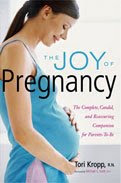
Of all the classes just described, the most important for first-time parents is a class on preparing for labor and birth. Although it can be helpful to read books and watch a video or two on birth, books and videos don’t provide enough information to help you fully understand labor or learn effective coping skills. Taking a class will help you learn as much as you can about your new adventure (never forget that this is a wonderful adventure!).
There are many benefits to taking a childbirth-preparation class. The most important is that you will gain a realistic expectation of what will happen during labor and birth. What’s more, you will learn various coping mechanisms and gain confidence in yourself. Some childbirth-preparation classes teach one childbirth “method” or another. To help you understand the differences between these schools of thought, I’ll give you a brief history. In the late 1940s and 1950s, women were often heavily medicated in labor, and they were alone. Their husbands were not welcome to participate, and there were no doulas or birth assistants. Women spent at least seven days in the hospital after giving birth. These practices led to a strong, much-needed movement to bring childbirth back into the family.
At this time, a physician named Grantley Dick-Read identified something he called the fear-tension-pain cycle. Dick-Read believed that a lack of knowledge makes laboring women afraid. Fear creates tension, tension increases pain, and pain makes us more afraid. Through this cycle, fear, tension, and pain escalate. Dick-Read developed a way to use information and relaxation to break the fear-tension-pain cycle. All the childbirth “methods” subsequently developed were intended to manage this cycle. During this same period, two other physicians, Ferdinand Lamaze and Robert Bradley, developed their own philosophies and methods of preparing women for labor. Although there are a few additional methods, such as the Alexander technique, which re-teaches the body how to move, think, and release tension, and hypnobirthing, which uses relaxation and repeated positive statements, most childbirth classes emphasize either the Lamaze or the Bradley approach. Both these popular methods advocate particular breathing and relaxation techniques for labor. With each approach, a woman is “coached” or supported by her partner or another caring person. The basic Lamaze philosophy is this: By understanding the labor process and by learning specific relaxation and breathing techniques, you can decrease the pain associated with labor contractions. By learning how to focus outside your body (for example, on a picture), you will be better able to cope. Today’s typical series of Lamaze classes, completed over several weeks or a weekend, lasts 10 to 12 hours.
The Bradley method, originally referred to as “husband coached delivery,” teaches natural childbirth, without medical interventions. Typically 12 weeks long, the training focuses on nutrition, exercise, and deep abdominal breathing for labor. According to Bradley, tuning in to your body, rather than focusing outside it, is the best way to cope with pain. Although Bradley instructors address the use of medications, the disadvantages of medications are emphasized over the advantages. In my experience, the Bradley breathing and coping techniques are excellent for women who want to labor without medications, but the critical view of hospitals often presented in Bradley classes may create unnecessary tension for couples choosing hospital birth.
Today, childbirth preparation classes often incorporate the best aspects of various childbirth methods, although many emphasize Lamaze breathing techniques. Whether you will be having your baby in a hospital, a birth center, or at home, I recommend that you attend a class that teaches the following things:
• Physiological aspects of labor and birth — what happens and when.
• Coping skills — relaxation, breathing patterns, massage, focus, and other ways to minimize pain in labor.
• Labor support measures — working with your body through positions, movement, and other natural ways to foster the process of labor.
• The partner’s role — how your mate can support you and work with the rest of your team.
• Accurate, unbiased information on the use of medications, monitoring the mother’s and the baby’s well being, and the circumstances in which medical procedures are needed. Even if you are planning a home birth, it is important to understand why transfer to a hospital might be needed and what might happen when you are there.
• Cesarean birth — not only why this might be necessary but what to expect should you need one. I tell my classes that a mother “gives birth” whether she does so vaginally or by cesarean section.
With most of us so busy these days, many childbirth-education programs offer a variety of scheduling options. You can select a weekly evening class, a weekend class, or even an abbreviated one-day course. I know of some weekend classes that are held at a resort, so that couples can combine childbirth education with a weekend getaway. If you are on bed rest, have an especially busy schedule, or just want personal attention, you can also ask about private classes. Because some classes are very popular, you should sign up soon to be sure of getting a place. But you don’t need to start the course right away; you will best retain what you learn if you take your class shortly before the birth. Unless the baby comes prematurely, the birth will occur between 37 and 42 weeks’ gestation. Seventy-five percent of women, in fact, deliver between weeks 39 and 41. So I recommend planning to complete your course by your 37th or 38th week.
~ Warmly, Tori Kropp







